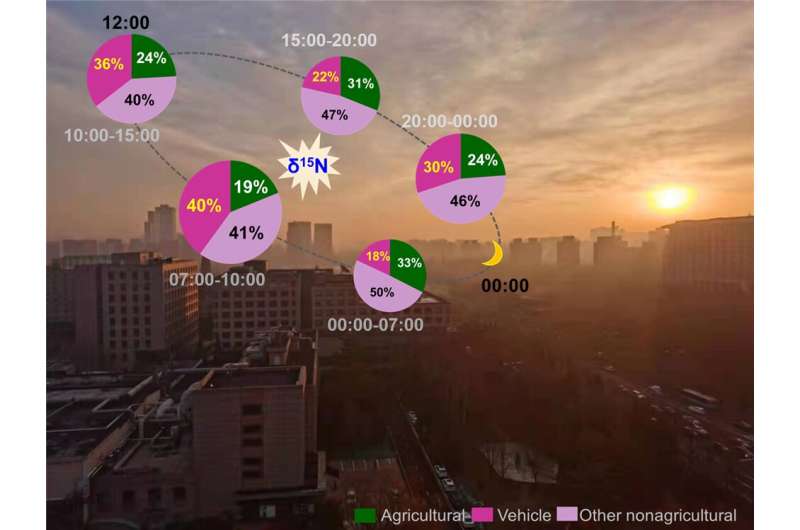Vehicular emissions enhance ammonia concentrations on winter mornings

Ammonia is readily reacting with acidic gases and can therefore fuel toxic air pollution. The major source of ammonia is traditionally believed to be fertilizer. However, the high levels of ammonia measured in urban air are puzzling, given that cites are mostly far from farmland.
A morning spike of ammonia concentrations typically occurs round 07:00 to 10:00 (local time), which is called morning peak by atmospheric chemists. This morning increase is explained in many ways, for example, dew volatilization after sunrise, soil and plants emissions due to elevated temperature, or downward mixing of ammonia from the upper polluted layer.
These all make sense but one question remains: What does ammonia trapped by dew come from in the first place? "Although automobile exhaust was proposed in some earlier publications, there was no sound method to provide quantitative evidence in identifying the ammonia morning increase," said Prof. Pan Yuepeng from the Institute of Atmospheric Physics (IAP) of the Chinese Academy of Sciences.
A research team led by Prof. Pan has used nitrogen isotopes to directly track the ammonia peak at hourly scale and unveiled the sources of ammonia in the air in winter mornings.
Their study was published in Environmental Science & Technology on Jan. 20.
Pan and his colleagues developed a new tracking approach to account for the nitrogen isotope fractionation, which can't be obtained by other existing methods, during ammonia gas-to-particle conversion. This approach allowed them to find the original sources of ammonia in the air, and to attribute different sources of ammonia that can best explain the observed ammonia morning peak in urban atmosphere.
After validating their measurements on wet-chemistry sampling method, Pan and his colleagues applied it to a typical haze pollution episode in winter in Beijing with a seven-day duration.
"Our nitrogen isotopic analysis provides evidence that vehicle emission in morning rush hour is a main driver of ammonia increase," Pan said. "In urban Beijing, 40 percent of ammonia concentrations that we observed in the morning are from vehicle emissions. However, we also find the values of nitrogen isotope of ammonia that appear to increase sharply in the morning."
These elevated signals can be good tracers in future strategies to control nonagricultural ammonia sources, especially for power plants, vehicles, and coal combustion that tend to have higher isotopic signatures relative to agricultural emissions.
Pan's team has also studied ammonia emissions in other seasons and are currently analyzing the data. So far it looks like the same finding can be applied to other seasons as well, said Pan.
More information: Mengna Gu et al, Vehicular Emissions Enhanced Ammonia Concentrations in Winter Mornings: Insights from Diurnal Nitrogen Isotopic Signatures, Environmental Science & Technology (2022). DOI: 10.1021/acs.est.1c05884
Journal information: Environmental Science & Technology
Provided by Chinese Academy of Sciences





















